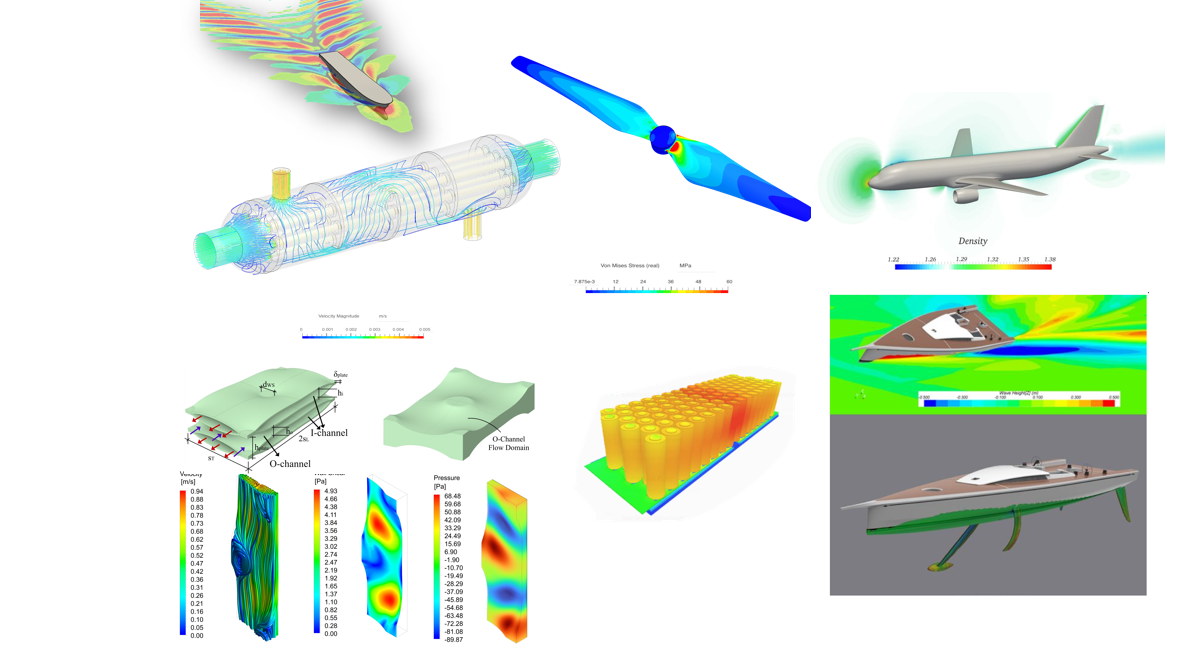Lab head: Dr Maryam Ghodrat
The CFD Lab's research is focused on investigating fundamental phenomena within complex turbulent flows. Emphasis is placed on understanding how these flows interact with solid surfaces, leading to the generation of aerodynamic forces, species mixing in the fluid, and heat transfer. These phenomena have broad applications, ranging from turbulent drag in commercial airplanes to the aerodynamics of small flyers, and from atmospheric boundary layer mixing to the complex high-fidelity full engine simulations.
The lab uses High-Performance Computing tools on massive parallel supercomputers, specifically through NCI Gadi, to analyse these complex flows. The expertise of the lab lies in the development and execution of Direct Numerical Simulation (DNS) and/or Large Eddy Simulation (LES) solvers.
Range of applications in "code development" :
The code development and models are for a wide range of applications, such as ocean engineering applications (ship hydrodynamics, wave/winds, stratified flows), aircraft drag prediction and energy systems (onshore and offshore wind turbines, wave energy converter etc.).
Research Interest:
- High-Fidelity Computational Fluid Dynamics Modeling and Simulation
- Simplified and reduced order methods
- Multi-Disciplinary Physics-Based Computational Methods
- High-Performance Computing
- Fluid-Structure Interaction
- Conceptual aerospace design
- Multi-objective and multi-disciplinary optimization
- Renewable Energy Systems
- Naval Hydrodynamics
- Verification and Validation
Our studies have a broad spectrum of applications including:
1-Environmental Fluid Mechanics:
- Interfacial mass and heat transfer.
- Air quality and air pollution.
- Transport of oil spills and other pollutants in the ocean.
- Simulation-based study of atmospheric pollutants transport in complex urban environments
2- Aerospace
Studying aerodynamics and propulsion covers the examination of flows, whether they occur around aerodynamic bodies (external flows, aerodynamics, or fluid dynamics) or within engines (internal flows or propulsion).
These fields play a crucial role in various aspects of aerospace engineering, including airplane aerodynamics, helicopter aerodynamics, jet propulsion, rocket propulsion, advanced propulsion, properties of the space environment, and more.
Our goal is prediction, observation, understanding, and control of complex three-dimensional unsteady flow fields focusing on aerodynamic applications. Principal application domains include challenges related to fluid-structure interaction, innovative control methods in aeronautical vehicles, and advancements in wind energy.
Our lab engages in research focused on developing computational algorithms and models applicable to fluid flows relevant to aerospace. This research involves fluid dynamic modeling at both fundamental and integrated system levels. A central theme in our lab revolves around using simulation and data-driven methods to address scientific and engineering inquiries, all while acknowledging the impact of numerical errors and modeling uncertainties on the predicted outcomes.
3-Engineering and Industrial Applications:
- Cavitation flows
- Renewable energy, e.g., wind energy, wave energy and solar energy
Software tools and resources
-
OpenFOAM
OpenFOAM is the 3rd most widely used CFD platform in the world and is becoming more popular every day. Our team uses OpenFOAM as it is widely validated, easily parallelized, and highly customizable.
-
ANSYS Fluent
Ansys Fluent is a general-purpose computational fluid dynamics (CFD) software used to model fluid flow, heat and mass transfer, chemical reactions, and more. Fluent offers a modern, user-friendly interface that streamlines the CFD process from pre- to post-processing within a single window workflow. Our team also uses ANSYS Fluent as it is industry’s most accurate and trusted solver and it maximizes our productivity with user-friendly interface.
-
Matlab & Python
Much of our work is done using custom codes and user created online toolboxes. Matlab and Python offer ideal development environments and built in tools for cutting edge aerospace analysis. Optimization toolboxes in both Matlab and Python are particularly useful.
-
cfMesh OPEN SOURCE
There are numerous meshing tools available for CFD. In the open source domain, cfMesh stands out among the best. High quality hex-dominant grid resulting in low non-orthogonality and skew lead to fast convergence and stable dependable results.
-
HPC & Linux
CFD and numerical analysis are computationally expensive. For large cases, our lab has access to NCI HPC resources on gadi,and UNSW HPC support through partnership with NCI.
Current Research Projects:
1- Artificial-intelligence active flow Control for reductIon of transport emIssions
2- Decomposition heat sources models for thermal abuse in Li-ion batteries
3-Adaptive mesh refinement for simulating complex flows with locally fine structures.
4-CFD simulation of the downwash airflow in UAVs
Research Team:
Dr Maryam Ghodrat
Dr Ao Li
Dr Shadi Abpeikar
PhD students:
1- Mostafa Mohamed Elarabi
2-Mahmoud Waly
3- Amirhossein Sabourishirazi
